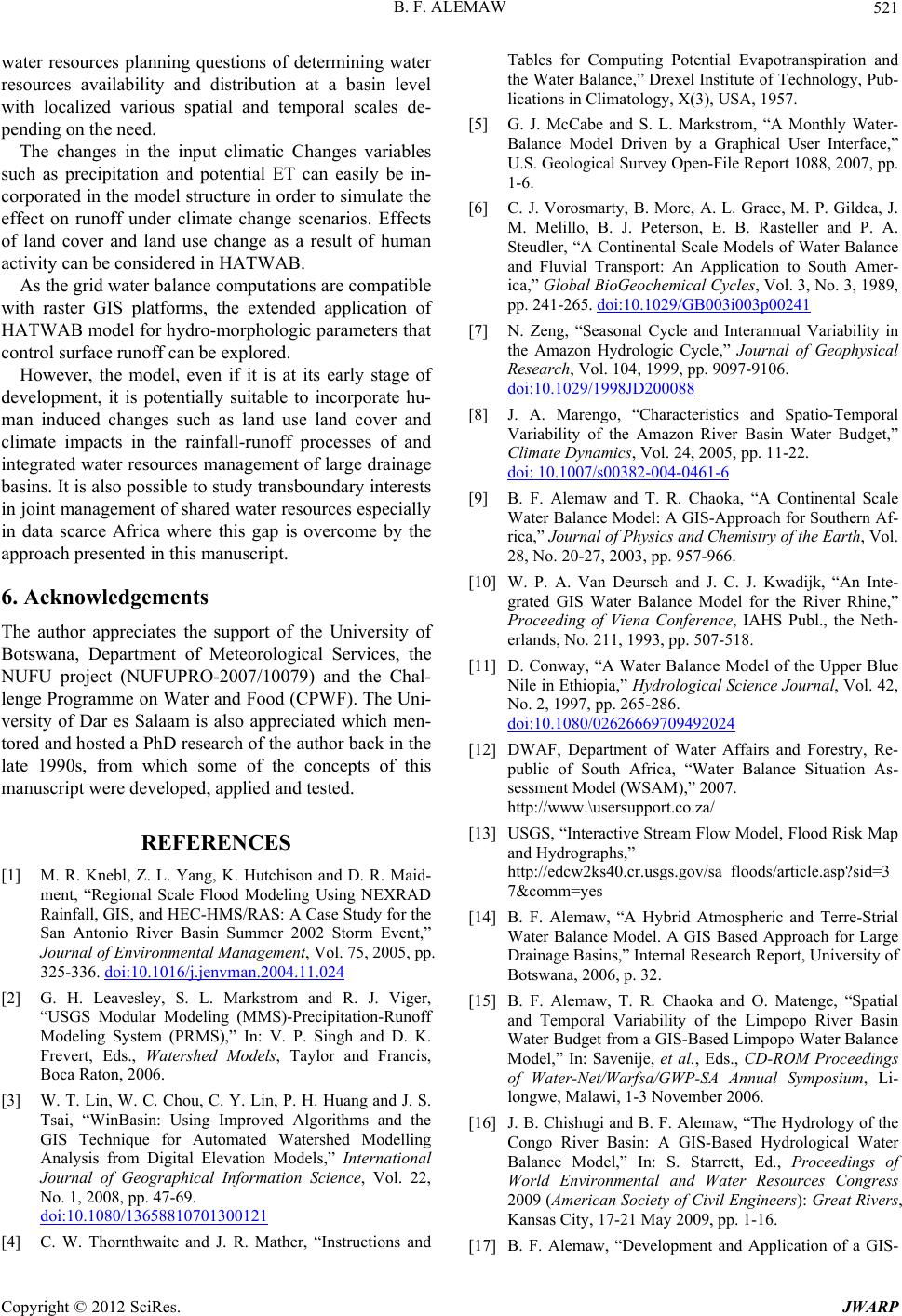
B. F. ALEMAW 521
water resources planning questions of determining water
resources availability and distribution at a basin level
with localized various spatial and temporal scales de-
pending on the need.
The changes in the input climatic Changes variables
such as precipitation and potential ET can easily be in-
corporated in the model structur e in order to simulate the
effect on runoff under climate change scenarios. Effects
of land cover and land use change as a result of human
activity can be considered in HATWAB.
As the grid water balance computations are compatible
with raster GIS platforms, the extended application of
HATWAB model for hydro-morp hologic parameters that
control surface runoff can be explored.
However, the model, even if it is at its early stage of
development, it is potentially suitable to incorporate hu-
man induced changes such as land use land cover and
climate impacts in the rainfall-runoff processes of and
integrated water resources management of large drainage
basins. It is also possible to study transboundary interests
in joint management o f shared water resources especially
in data scarce Africa where this gap is overcome by the
approach presented in this man uscript.
6. Acknowledgements
The author appreciates the support of the University of
Botswana, Department of Meteorological Services, the
NUFU project (NUFUPRO-2007/10079) and the Chal-
lenge Programme on Water and Food (CPWF). The Uni-
versity of Dar es Salaam is also appreciated which men-
tored an d hos ted a Ph D rese arch of the au thor b ack in th e
late 1990s, from which some of the concepts of this
manuscript were developed, applied and tested.
REFERENCES
[1] M. R. Knebl, Z. L. Yang, K. Hutchison and D. R. Maid-
ment, “Regional Scale Flood Modeling Using NEXRAD
Rainfall, GIS, and HEC-HMS/RAS: A Case Study for the
San Antonio River Basin Summer 2002 Storm Event,”
Journal of Environmental Management, Vol. 75, 2005, pp.
325-336. doi:10.1016/j.jenvman.2004.11.024
[2] G. H. Leavesley, S. L. Markstrom and R. J. Viger,
“USGS Modular Modeling (MMS)-Precipitation-Runoff
Modeling System (PRMS),” In: V. P. Singh and D. K.
Frevert, Eds., Watershed Models, Taylor and Francis,
Boca Raton, 2006.
[3] W. T. Lin, W. C. Chou, C. Y. Lin, P. H. Huang and J. S.
Tsai, “WinBasin: Using Improved Algorithms and the
GIS Technique for Automated Watershed Modelling
Analysis from Digital Elevation Models,” International
Journal of Geographical Information Science, Vol. 22,
No. 1, 2008, pp. 47-69.
doi:10.1080/13658810701300121
[4] C. W. Thornthwaite and J. R. Mather, “Instructions and
Tables for Computing Potential Evapotranspiration and
the Water Balance,” Drexel Institute of Technology, Pub-
lications in Climatology, X(3), USA, 1957.
[5] G. J. McCabe and S. L. Markstrom, “A Monthly Water-
Balance Model Driven by a Graphical User Interface,”
U.S. Geological Survey Open-File Report 1088, 2007, pp.
1-6.
[6] C. J. Vorosmarty, B. More, A. L. Grace, M. P. Gildea, J.
M. Melillo, B. J. Peterson, E. B. Rasteller and P. A.
Steudler, “A Continental Scale Models of Water Balance
and Fluvial Transport: An Application to South Amer-
ica,” Global BioGeochemical Cycles, Vol. 3, No. 3, 1989,
pp. 241-265. doi:10.1029/GB003i003p00241
[7] N. Zeng, “Seasonal Cycle and Interannual Variability in
the Amazon Hydrologic Cycle,” Journal of Geophysical
Research, Vol. 104, 1999, pp. 9097-9106.
doi:10.1029/1998JD200088
[8] J. A. Marengo, “Characteristics and Spatio-Temporal
Variability of the Amazon River Basin Water Budget,”
Climate Dynamics, Vol. 24, 2005, pp. 11-22.
doi: 10.1007/s00382-004-0461-6
[9] B. F. Alemaw and T. R. Chaoka, “A Continental Scale
Water Balance Model: A GIS-Approach for Southern Af-
rica,” Journal of Physics and Chemistry of the Earth, Vol.
28, No. 20-27, 2003, pp. 957-966.
[10] W. P. A. Van Deursch and J. C. J. Kwadijk, “An Inte-
grated GIS Water Balance Model for the River Rhine,”
Proceeding of Viena Conference, IAHS Publ., the Neth-
erlands, No. 211, 1993, pp. 507-518.
[11] D. Conway, “A Water Balance Model of the Upper Blue
Nile in Ethiopia,” Hydrological Science Journal, Vol. 42,
No. 2, 1997, pp. 265-286.
doi:10.1080/02626669709492024
[12] DWAF, Department of Water Affairs and Forestry, Re-
public of South Africa, “Water Balance Situation As-
sessment Model (WSAM),” 2007.
http://www.\usersupport.co.za/
[13] USGS, “Interactive Stream Flow Model, Flood Risk Map
and Hydrographs,”
http://edcw2ks40.cr.usgs.gov/sa_floods/article.asp?sid=3
7&comm=yes
[14] B. F. Alemaw, “A Hybrid Atmospheric and Terre-Strial
Water Balance Model. A GIS Based Approach for Large
Drainage Basins,” Internal Research Report, University of
Botswana, 2006, p. 32.
[15] B. F. Alemaw, T. R. Chaoka and O. Matenge, “Spatial
and Temporal Variability of the Limpopo River Basin
Water Budget from a GIS-Based Limpopo Water Balance
Model,” In: Savenije, et al., Eds., CD-ROM Proceedings
of Water-Net/Warfsa/GWP-SA Annual Symposium, Li-
longwe, Malawi, 1-3 November 2006.
[16] J. B. Chishugi and B. F. Alemaw, “The Hydrology of the
Congo River Basin: A GIS-Based Hydrological Water
Balance Model,” In: S. Starrett, Ed., Proceedings of
World Environmental and Water Resources Congress
2009 (American Society of Civil Engineers): Great Rivers,
Kansas City, 17-21 May 2009, pp. 1-16.
[17] B. F. Alemaw, “Development and Application of a GIS-
Copyright © 2012 SciRes. JWARP